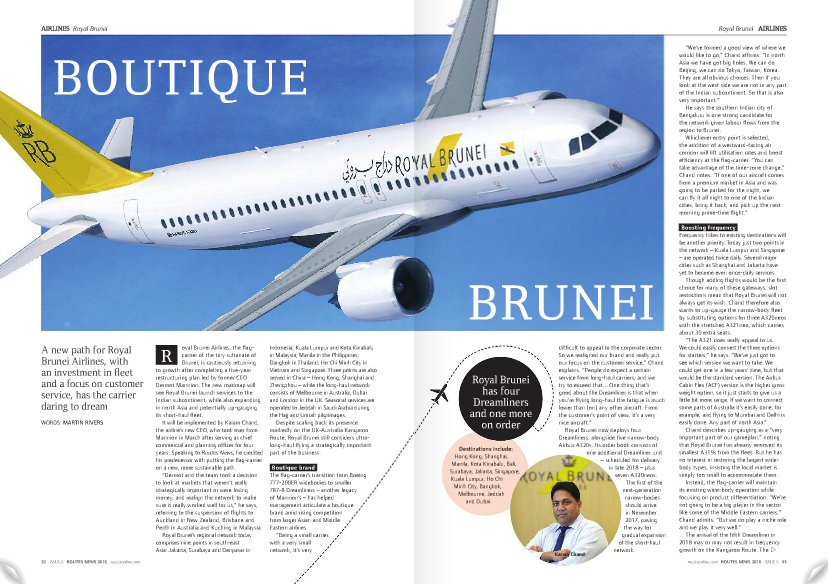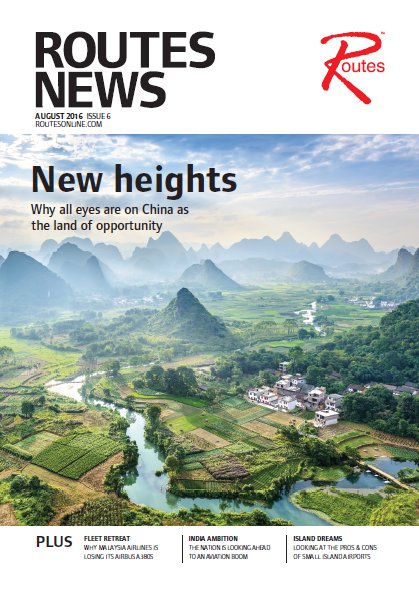Royal Brunei Airlines, the flag carrier of the tiny sultanate of Brunei, is cautiously returning to growth after completing a five-year restructuring plan led by former CEO Dermot Mannion. The new roadmap will see Royal Brunei launch services to the Indian subcontinent, while also expanding in north Asia and potentially up-gauging its short-haul fleet.
It will be implemented by Karam Chand, the airline’s new CEO, who took over from Mannion in March after serving as chief commercial and planning officer for four years. Speaking to Routes News, he credited his predecessor with putting the flag-carrier on a new, more sustainable path.
“Dermot and the team took a decision to look at markets that weren’t really strategically important or were losing money, and realign the network to make sure it really worked well for us,” he says, referring to the suspension of flights to Auckland in New Zealand, Brisbane and Perth in Australia and Kuching in Malaysia.
Royal Brunei’s regional network today comprises nine points in south-east Asia: Jakarta, Surabaya and Denpasar in Indonesia; Kuala Lumpur and Kota Kinabalu in Malaysia; Manila in the Philippines; Bangkok in Thailand; Ho Chi Minh City in Vietnam and Singapore. Three points are also served in China – Hong Kong, Shanghai and Zhengzhou – while the long-haul network consists of Melbourne in Australia, Dubai and London in the UK. Seasonal services are operated to Jeddah in Saudi Arabia during the Hajj and Umrah pilgrimages.
Despite scaling back its presence markedly on the UK-Australia Kangaroo Route, Royal Brunei still considers ultralong- haul flying a strategically important part of the business. The flag-carrier’s transition from Boeing 777-200ER widebodies to smaller 787-8 Dreamliners – another legacy of Mannion’s – has helped management articulate a boutique brand amid rising competition from larger Asian and Middle Eastern airlines.
“Being a small carrier with a very small network, it’s very difficult to appeal to the corporate sector. So we realigned our brand and really put our focus on the customer service,” Chand explains. “People do expect a certain service from long-haul carriers, and we try to exceed that... One thing that’s good about the Dreamliner is that when you’re flying long-haul the fatigue is much lower than [on] any other aircraft. From the customer’s point of view, it’s a very nice aircraft.”
Royal Brunei now deploys four Dreamliners, alongside five narrow-body Airbus A320s. Its order book consists of one additional Dreamliner unit – scheduled for delivery in late 2018 – plus seven A320neos. The first of the next-generation narrow-bodies should arrive in November 2017, paving the way for gradual expansion of the short-haul network.
“We’ve formed a good view of where we would like to go,” Chand affirms. “In north Asia we have got big holes. We can do Beijing, we can do Tokyo, Taiwan, Korea. They are all obvious choices. Then if you look at the west side we are not in any part of the Indian subcontinent. So that is also very important.”
He says the southern Indian city of Bengaluru is one strong candidate for the network given labour flows from the region to Brunei. Whichever entry point is selected, the addition of a westward-facing air corridor will lift utilisation rates and boost efficiency at the flag-carrier.
“You can take advantage of the time-zone change,” Chand notes. “If one of our aircraft comes from a premium market in Asia and was going to be parked for the night, we can fly it all night to one of the Indian cities, bring it back, and pick up the next morning prime-time flight.”
Frequency hikes to existing destinations will be another priority. Today just two points in the network – Kuala Lumpur and Singapore – are operated twice daily. Several major cities such as Shanghai and Jakarta have yet to become even once-daily services.
Though adding flights would be the first choice for many of these gateways, slot restrictions mean that Royal Brunei will not always get its wish. Chand therefore also wants to up-gauge the narrow-body fleet by substituting options for three A320neos with the stretched A321neo, which carries about 30 extra seats.
“The A321 does really appeal to us. We could easily convert the three options for starters,” he says. “We’ve just got to see which version we want to take. We could get one in a few years’ time, but that would be the standard version. The Airbus Cabin Flex (ACF) version is the higher gross weight option, so it just starts to give us a little bit more range. If we want to connect some parts of Australia it’s easily done, for example, and flying to Mumbai and Delhi is easily done. Any part of north Asia.”
Chand describes up-gauging as a “very important part of our gameplan,” noting that Royal Brunei has already removed its smallest A319s from the fleet. But he has no interest in restoring the largest widebody types, insisting the local market is simply too small to accommodate them.
Instead, the flag-carrier will maintain its existing wide-body operation while focusing on product differentiation. “We’re not going to be a big player in the sector like some of the Middle Eastern carriers,” Chand admits. “But we do play a niche role and we play it very well.”
After slashing its Australasian footprint from three destinations to just one in 2011, Royal Brunei is settling into life as a niche player on the ultra-competitive Kangaroo Route between the UK and Australia. The loss of Perth, Brisbane and Auckland coincided with the launch of a new service to Melbourne – initially served four-times weekly – which connects with London via two stops in Brunei and Dubai. The streamlined operation preserves Royal Brunei’s exposure to the strategically important market without weighing down its finances too heavily.
“In a very short time we were able to go to a daily flight [to Melbourne],” Chand says. “We are competing against 15 or 16 airlines serving one-stop or two-stop products on the Kangaroo Route. It’s a very competitive market and we are holding our own ground.”
Although the second stop in Dubai creates a relatively lengthy journey time, Chand talks up the improved onboard humidity and air pressure of Royal Brunei’s Dreamliner fleet. He also says the flag-carrier’s alcohol-free service makes for a more relaxed environment, noting that “a number of the customers who choose us because we are a dry airline are westerners”.
Rather than adding more points in Australia and Europe, Royal Brunei is now focused on developing its interline agreements into full-blown codeshares. “That’s the most sensible option for us,” Chand insists, pointing to existing cooperation with British Airways, Virgin Australia, Qantas and Air New Zealand.
The arrival of the fifth Dreamliner in 2018 may or may not result in frequency growth on the Kangaroo Route. The aircraft has also proven popular on regional routes such as Hong Kong, and retaining a standby unit would build slack into the system during the Hajj and Umrah. “With the four aircraft it’s quite challenging when we are running Jeddah operations,” Chand stresses. “At any given point in time we’ve got three aircraft in the air, so when the fourth one is in the air as well it limits your choices if there are technical issues.”
Royal Brunei’s aspirations in the point-to-point market are equally down to earth. Although Brunei is one of the wealthiest countries in the world per capita, its population of 420,000 places a low ceiling on growth potential for outbound travel.
Inbound travel is meanwhile hindered by the sultanate’s deeply conservative reputation. Brunei enacted a Sharia penal code in 2014 that includes harsh penalties and capital punishment for certain crimes. While implementation of the harshest penalties has been delayed, the government already bans public consumption of food during Ramadan and public celebrations of Christmas.
“Ultimately, Bruneians have to decide which way they want to go,” Chand says of the need to strike a balance between defending cultural heritage and opening up to the world. "There are discussions within Brunei among the decision makers about diversifying the economy, and when that starts to take place then of course the tourism sector will open up. At the moment it’s a very small part of the total traffic flow. In the future it will develop, and that will have a big impact on Royal Brunei. That creates opportunities straight away for us.”
 |
This article is modified from an original feature that appeared in... ROUTES NEWS - ISSUE 6, 2016 PLEASE CLICK HERE to view the magazine. |
 |
